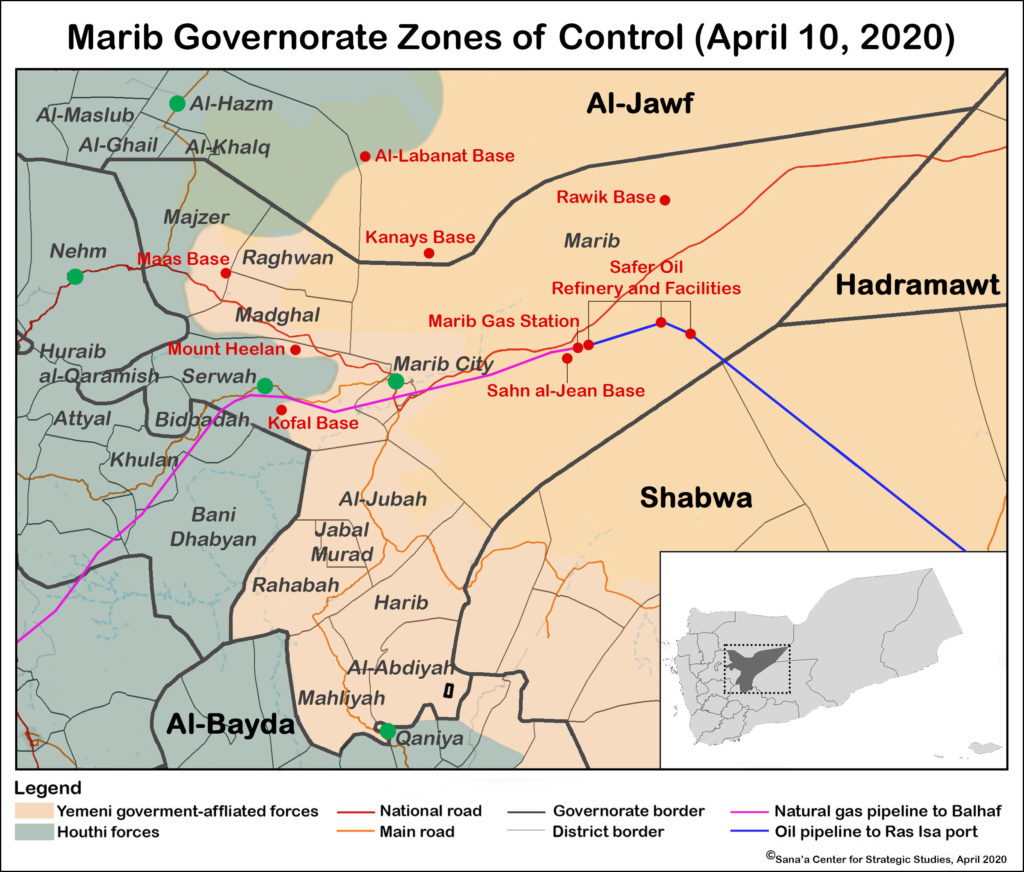Following the fall of Al-Hazm, the capital of Al-Jawf governorate, to the armed Houthi movement at the end of February, all eyes have turned to neighboring Marib. The wealthiest governorate in the north, Marib has oil and gas wells, the Safer oil refinery, and a major power station that had supplied most of Yemen with electricity before the war. Marib also hosts the largest group of northern rivals to the Houthis and the largest numbers of troops loyal to President Abdo Rabbu Mansour Hadi, which are units of the national army. It is the home of powerful Sunni Shafi’i tribes, including Abidah, Murad, Jadaan and others, and is also a center of power for the Yemeni Congregation for Reform (Islah), among the largest of Yemen’s political parties and the most important local rival of the Houthis.
Within its Marib sanctuary and bolstered by its resources, Islah has established itself as the main decision-maker in one of Yemen’s most strategically important governorates. Marib is also one of the last sources of political power for the Yemeni government. Its loss would undermine the Saudi-led coalition’s war in Yemen. Capturing Marib would give the Houthis control over most of the north, access to the governorate’s vital resources and a highway to southern governorates that lack the ability to resist the Houthis. This includes Shabwa and Hadramawt, which along with Marib make up the base of Yemen’s hydrocarbon resources. If Marib were to fall, it could begin a domino effect that ends with the Houthis further empowered in the struggle for political control of Yemen through their control of additional territory and people along with all major sources of wealth in the country..
Meanwhile, the two-week cease-fire announced by Saudi Arabia on April 9 is unlikely to halt fighting in Marib. The Houthis know well that accepting any truce would give those defending the governorate a chance to reorganize their ranks and defenses, making it difficult to regain the current offensive momentum. And despite the UN’s call for all warring parties to quit fighting in response to the threat from COVID-19, the current crisis actually provides the Houthis a rare opportunity to launch wide attacks across multiple areas of the country while the rest of the world is preoccupied and not paying attention to Yemen.
Marib had achieved relative stability after first confronting the Houthis in 2015, leaving the rebels confined to the governorate’s Serwah area. The frontlines cooled and heated up from time to time, but without any serious attempt by either warring party to change the zones of control. However, the capture of Al-Jawf gave the Houthis an appetite to reconfigure the situation on the ground in Marib, and to this end, they are pressing forces loyal to the internationally recognized Yemeni government on three axes.
First, fighting in the southwest along the Serwah front has escalated to a level unprecedented since the beginning of the war. Serwah has witnessed the highest rate of battles of anywhere in the governorate as the Houthis attempt to advance and cement their control over the entire district, including the strategic Kofal military camp. Kofal – currently a site of clashes between the warring parties – overlooks the city of Marib from the west, and its fall would leave only a few strategic positions, most prominently Al-Tabbah al-Msariyah, between the Houthis and the governorate capital.
The second axis of the Houthi offensive comes from the west, starting from the strategic Nehm area in Sana’a governorate. This frontline has expanded to include Marib’s Majzar to the north, after the Houthis advanced into the district from Al-Ghail and Al-Khalq districts in neighboring Al-Jawf governorate.
The Houthi military pressure is completed from the north, specifically from Al-Jawf desert. This offensive aims to cut the international highway that links Marib to Al-Jawf and the Al-Wadiah border crossing with Saudi Arabia, and to Hadramawt. Capturing this thoroughfare also moves the Houthis closer to Marib’s Safer oil refineries. There are also indications that the Houthis are seeking to pressure Marib from the south. An attack on the Qaniya front in Al-Bayda governorate, which shares a border with Marib, was slowed by pro-government forces in mid-March.

The current military pressure by the Houthis has been accompanied by political messages sent via different intermediaries to the local authority in Marib, headed by Governor Sultan al-Aradah. These include demands for a share of oil and gas revenues, as well as requests that the local authorities ease up their pressure on the Al-Ashraf tribes, which are Houthi supporters, and inclusion of tribe members in the administration of the governorate.
It is still unclear if the Houthis aim to capture the city of Marib, which would prove a much more difficult fight than the battle for Al-Jawf. The vast number of casualties from the Serwah battles are merely an indication of the massive cost that the Houthis would bear if this is their ultimate purpose. To achieve this, the Houthis would likely need two things. The first would be a major military breakthrough that puts them at a better negotiating position, whether in Serwah or along another front. Second, a Houthi takeover would require stirring up internal dissent in Marib and capitalizing on the frustration of local tribes and other political parties at five years of Islah domination in the governorate since the previous Houthi defeat in 2015.
Local tribes, despite their anger with Islah, have an even more complex position toward the Houthis. These tribes have a prominent sense of their Sunni identity that puts them at odds with the Shia Zaidi Houthis. Significantly, the influential Murad tribe believes that the Houthis hold historic animosity toward them: Imam Ali bin Abi Talib (the symbolic father of all Shia sects in the Islamic world) was assassinated by Abd al-Rahman ibn Muljam, a member of the Murad tribe, in 661. In more recent history, Yahya Mohammed Hamid ed-Dine, the Zaidi imam of the Mutawakkilite Kingdom of Yemen, was killed in 1948 by Al-Qardaei, one of the most prominent sheikhs of the Murad tribe.
The tribal challenge in Marib is the most important calculation for the Houthis in the governorate. If the group is unable to reach settlements as they have with tribes in other governorates (for example, in Al-Jawf and Al-Bayda), the other option is a difficult, complicated and costly military confrontation. The Abidah tribe is currently resisting Houthi attacks in the desert in the governorate’s northern border with Al-Jawf. Meanwhile, the Murad and Al-Jadaan tribes are battling the Houthis in Majzar and Serwah districts, in addition to Qaniya district in neighboring Al-Bayda, where Houthi pressure remains high, especially on the Murad tribe. An implicit goal for the Houthis appears to be raising the human cost for the Murad tribe to trigger anger over the fact that the tribe’s sacrifices are not met with commensurate privileges in the governorate. However, it appears for now that the Murad tribe’s sense of animosity toward the Houthis is greater than its sense of injustice toward their main rival the Abidah over the Murad’s perceived political exclusion from decision-making in the governorate.
The fact that Marib’s tribes are bearing the greatest burden fighting the Houthis reveals a significant weakness in the performance of regular military forces in the battles over the fate of the governorate. The ineffectiveness of official army units can be mainly attributed to widespread corruption in the recruitment and armament process. Among the sizable military brigades on paper, there exists a prevalence of ‘ghost soldiers’, who do not actually exist and whose salaries are shared among the various military commanders. Another major problem stems from the leadership of these brigades. The dominance of Islah and its ally, Vice President Ali Mohsen al-Ahmar, in the governorate over the years has led to the exclusion of professional officers deemed insufficiently loyal and their replacement with figures from outside the army who lack competence.
The fall of Al-Jawf and the current battle over Marib has exposed the decayed capabilities of military forces affiliated with the government and is directly reflected at all leadership levels of the Yemeni army up to Minister of Defense Mohammed al-Maqdishi and the vice president, Ali Mohsen. Among certain political and military circles there are now doubts about the wisdom of them remaining in their positions. Importantly, the army’s poor performance recently – including being driven from Aden by the Southern Transitional Council last year and a sudden defeat to the Houthis in Nehm in January – will likely push Saudi Arabia to reconsider the current military leadership. The exception to this potential leadership shakeup appears to be Sagheer bin Aziz, the newly appointed chief of staff who has emerged as a rising star. However, the prospects of Bin Aziz reorganizing military forces under his command and making any significant difference are complicated by several factors, including the limited time he has spent in his position and the constant Houthi military pressure. Islah also views him with suspicion and views any power and success he accumulates as coming at the expense of the party’s grip on the army. This has played out in practice as Bin Aziz has empowered competent officers and military leaders who were excluded previously due to their lack of affiliation with Islah.
The results of the fighting in Marib will also determine the future position of Sultan al-Aradah, governor of Marib who belongs to the Abidah tribe. If he can successfully manage the complex relationship between tribal parties and political forces, including pressure from Islah, and defend Marib from the Houthis, he will cement his status on the Yemeni government side at the expense of many who are watching his rise with concern.
The battle of Marib is a critical turning point in the Yemen war. A military victory for the Houthis would pave the way for their dominance of the country’s most resource-rich areas and represent a huge blow for the legitimate government. On the government side, the defense of Marib is a major test for the Yemeni military and five years of Saudi support for it. A Houthi defeat in Marib could undermine their ambitions, give new life to the group’s opponents and rivals, weaken the current Houthi negotiating position with Saudi Arabia and force international observers to revise current estimations of the movement’s strength.
Maged Al-Madhaji is a co-founder and executive director of the Sana’a Center for Strategic Studies. He tweets at @MAlmadhaji.
The Sana’a Center for Strategic Studies is an independent think-tank that seeks to foster change through knowledge production with a focus on Yemen and the surrounding region. The Center’s publications and programs, offered in both Arabic and English, cover diplomatic, political, social, economic, military, security, humanitarian and human rights related developments, aiming to impact policy locally, regionally, and internationally.

 اقرأ المحتوى باللغة العربية
اقرأ المحتوى باللغة العربية